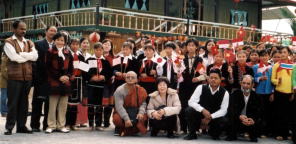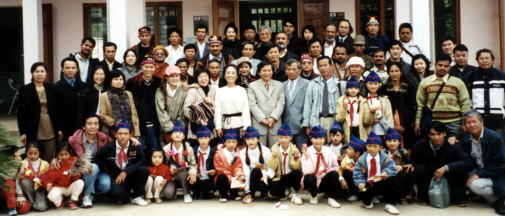
No.203-9
Taking part in the üeStudy Tour to Terakoyas in Vietnamüf
Takeko Hashimoto, Vice President
 |
With other members from Gifu, Kumamoto, and Osaka UNESCO Associations, I took part in a Study Tour to Vietnam between 24th November and 2nd December. The National Federation of UNESCO Associations in Japan chose these four UNESCO Associations from 95 Japanese UNESCO Associations, for their contribution to the üemiswritten postcards campaignüf.
First, we attended a three-day workshop in Hanoi, and listened to reports on the Terakoya movement from representatives from Afghanistan, India, Cambodia, Nepal and Pakistan. After that, we set off to visit Terakoyas. About 50 members from many countries caught the overnight sleeping car north to Lao Cai in the mountains. After that there was a six-hour bus ride to Tam Duong.
It was a fascinating journey as we passed terraced fields on the steep hillsides, not to say a little alarming as the driver wended his way round tight curves in the road. Sometimes it was so foggy that the driver could only just see the guard rail.
To my delight, children in folk costume lined both sides of the street, welcoming us by waving the flags of our different countries. After receiving welcome greetings and listening to local reports, we observed lessons on mathematics and on agriculture guidance. There is a library; books, but not much furniture so some children were standing as they read. Unfortunately we could not chat with them because there was no interpreter around. We went to an open-air theatre at night and enjoyed listening to many Vietnamese songs and watching their dances. Then out of the blue came a request for Mr. Okukawa (National Federation of UNESCO Associations) and participants from Nepal, India and Afghanistan, to show their traditional forms of entertainment. Their impromptu versatility really impressed the audience.
We left at eight the next morning and took another one-hour bus trip to the Binh Lu Terakoya. We observed an aquaculture project, which gets training support from Terakoya. Water cisterns were fully equipped to cater for spawn and young fish, and we could also see fully grown fish. The success of the project however was limited, since only three or so out of ten trainees had adequate land and finance to make their new knowledge commercially successful.

The üecollecting miswritten postcardsüf season has come round again. We collected as many postcards as possible in earlier campaigns, and this study tour showed how the money raised is being used and what the campaign has produced. I was very impressed. As we left, people smiled as they ran after us along the steep hillsides, holding their children in their arms. I was very touched by their warm feelings. And even though we could not communicate with language, the tour was a wonderful experience. The Vietnamese government is actively aiding literacy education and currently running forty Terakoyas. The participants from Afghanistan could see similar potential for such progress in their own country. There are many people waiting for our help and I thank you for your continued support.
Lastly, I would like to express my utmost appreciation to the staff of eachü@UNESCO Association who sent us on the tour, and also the staff of theü@National Federation of UNESCO Associations who planned, managed and gave support on this tour.
Picture above: Middle of the front row, the author of this article,
Vice President, Takeko Hashimoto
Right picture: the Vietnam Study Tour Group from several countries
next page